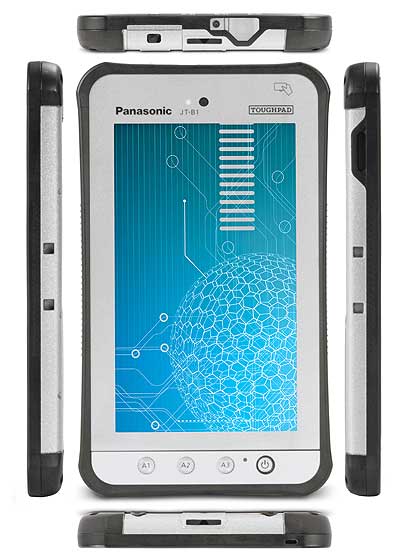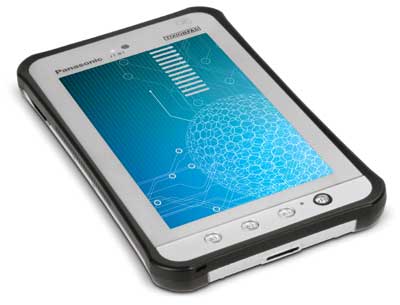|
Panasonic Toughpad JT-B1
A tough and handy Android 4.0 tablet with a 7-inch procap multi-touch screen for folks working out there in the field where it can get bumpy and wet
(by Conrad H. Blickenstorfer)
On January 8, 2013, Panasonic introduced the Android-based 7-inch Toughpad JT-B1 together with the 10.1-inch Windows 8-based Toughpad FZ-G1. The new tablets join the existing Android-based 10.1-inch Toughpad A1, giving Panasonic a whole trio of "new era" ruggedized tablets, hedging its bets by offering tablets in both major operating systems platforms that do battle with Apple's still category-leading (albeit non-rugged) iPad.

While the 2013 CES show was Panasonic's little tablet's official introduction, the company had actually already shown the small Toughpad at the November 2011 launch of its larger Android Toughpad A1 in Dallas, Texas. At that time, the smaller version was still kept under glass, and a closer look shows that while the overall design of the B1 is relatively unchanged since the prototype, there have been many enhancements and refinements.
In terms of specs, the Toughpad JT-B1 (we're not sure what the "JT" designation stands for) is relatively standard Android tablet fare. There's a Texas Instruments OMAP-4460 System-on-Chip under the hood, a very frugal design with dual ARM Cortex-A9 cores, an integrated PowerVR SGX 540 Graphics Core, and a thermal design power of just 0.6 watts. Word on the street is that the chip clocks somewhere between a Tegra 2 and a Tegra 3. There's a 17:10 aspect ratio wide-format 7-inch capacitive 4-point multi-touch screen with 1024 x 600 pixel resolution. That would be marginal for Windows (early netbooks used that resolution), but it's adequate for Android on a small screen. The display is bright (500 nits) and benefits from anti-glare and anti-reflective coatings that's usually missing from consumer media tablets. This tablet is touch-only, though, unlike Panasonic's two larger new era tablets that also include an active pen.
Completing the major tech specs are a gig of RAM and 16GB of Flash that can be augmented via a micro-SD card slot. There's dual-band 802.11a/b/g/n WiFi, Bluetooth version 4, and optional embedded 3G or 4G LTE wireless broadband. The 13-megapixel rear camera far exceeds the other two Toughpads in resolution. The front camera has 1.3-megapixel resolution suitable for 720p video conferencing. Like most smartphones and small tablets, the Toughpad B1 doesn't have a lot of ports. In fact, there's just a single micro-USB port. But, unlike its two larger siblings, the B1 includes NFC (Near Field Communication), which allows for very short range radio contact for certain types of data exchanges (see Wikipedia on NFC). It's for the kind of quick contacts people used to use IR for.

This being a Toughpad, the B1, which weighs just 1.2 pounds, benefits from the same fortified industrial design and construction Panasonic has specialized in since releasing its first Toughbook computers back in the mid 1990s. While consumer media tablets are sleek and elegant, they are quite fragile. Toughpads aren't. The little B1 can handle a 5-foot drop, it can handle extreme operating temperatures, and it is sealed to IP65 specifications, where the "6" means it's completely dustproof, and the "5" means it's protected against low pressure water jets from all directions (definitely not recommended with an iPad, or a Microsoft Surface tablet).
Add to that the bright 500 nit display that makes the tablet usable outdoors, various security options that mean nothing to consumers but everything in enterprise settings, a user-replaceable 8-hour battery, various other ruggedness specs and certifications, and a 3-year warranty with true business-class support, and it's clear that Panasonic designed this Toughpad as a tool for jobs such as inventory control, field sales, asset management, mobile payments, route delivery, and similar applications where a tablet may get dropped or rained on.
As far as cost goes, the Toughpad B1 is quite reasonable for a rugged device. It starts at US$1,199. Even in the world of rugged computing where the initial purchase price is almost irrelevant compared to how well a product holds up out there in the field, and how long it will last, an attractive price always helps.
|



